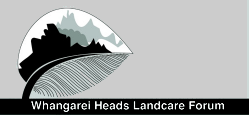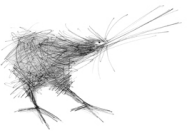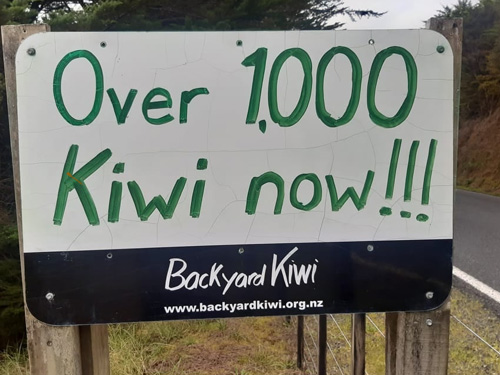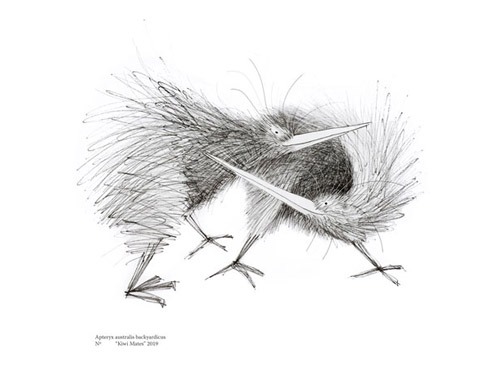2021 June Report
Over 1000 adult kiwi at the Whangarei Heads!!!
After 20 years of community driven kiwi recovery work at the Whangarei Heads we now have a kiwi population of over 1000 – up from just 80 kiwi in 2001. This is a fantastic milestone to make thanks to a huge team effort. A network of stoat traps supported by controlled pulses of toxin has controlled stoats allowing good chick survival. Community engagement through public kiwi releases, kiwi monitoring and storytelling has led to good dog control dramatically dropping the loss of adult kiwi to dog kills. Thanks to a great community supported by the NRC, Kiwi Coast, Department of Conservation, Kiwis for kiwi and many others. Special thanks to Ngati Hine for the gift of kiwi to supplement our remnant population that has now become a kiwi stronghold.
Kiwi Counting – how do we know kiwi numbers?
Data from 17 of the 20 call counting sites is in to date so the numbers are yet to finalised but both the number of calls and also the number of individual kiwi identified is well up on the past two years. The population estimate in 2020 was 885 and the average call count per site was 7.3 calls/hour. Provisionally our numbers for 2021 are 1055 kiwi with a call rate of 11 calls/hour/site. This increase is probably due to a combination of factors:
- Importantly our population is growing with more adult kiwi reaching breeding age from chicks that hatched 3-5 years ago!
- The kiwi counting period better coincided with the peak calling time of breeding season this year making for a more accurate count.
- The past two call counts we were suffering from droughts so calls were lower than expected due to kiwi in poor condition not calling.
- We had a refresher training session for kiwi counters and introduced some younger ears to the team (some of us are just less capable of hearing distant kiwi now).
- Although weather and surf conditions were tricky at times (surf noise is a problem when listening on the coast) there were reasonable numbers of good listening nights for our hard working counters to work accurately.
I will crunch the final data and put a more detailed report in next month’s update.
Kiwi chick on Parua Bay beach
A 900g kiwi chick was found washed up on the beach at the end of Ritchie Road, Parua Bay. This was just after the big storm we had that had large waves wash well up on some beaches. The chick had no signs of bruising or wounds so was unlikely to be a stoat or dog kill victim. Drowning is the most likely cause of death.
Backyard Kiwi Predator Control Program:
Catches for June : 1 stoat, 5 weasels, 3 cats, 69 rats, 16 hedgehogs, 2 possums.
This gives us 2020/2021 season totals of: 14 stoats, 18 weasels, 22 cats, 733 rats, 136 hedgehogs, 68 possums
This is our lowest stoat catch year ever (we got 55 stoats in our first trapping season back in 2002). The ongoing trapping at the Heads and expanded trapping further inland in the Kiwi Link area and even further afield is having a positive impact but the main reason for low stoats numbers this year will be the effective Kiwi Saver (1080) pulse on Manaia and some private blocks.
Thanks to Predator Free Whangarei for bringing DNA expert Andrew Veale to the Heads to present on his work while he was up here investigating the possibility of using possum DNA samples (possum ears) from trapped possums to monitor the possum population dynamics. Andrew is the guy who mapped the stoat genome and has done important work on tracking stoat population movements (and trap shyness) through DNA analysis. We are going to start keeping stoat DNA samples (ears) for possible analysis and then will be able to find out when we have trap shy stoats or reinvading stoats to help better control them.
What your kiwi have been up to:
With good moisture levels leading to well fed kiwi the breeding season sounded to be very busy judging by the high call counts. The fertilised females are now developing eggs and laying them for the males to incubate. So the kiwi dads’ activities are dropping as they settle in on the eggs for the long haul ahead.
Whangarei Heads radio tracked Kiwi.
- Wally – Has settled in the NE area of his territory at the end of Campbell and has started nesting in a pampas bush in a patch of gorse there. On 30/6/21 he had been nesting 11 days and was active for 3 hours nightly- so he is off to a good start.
- Ross – In the valley at the top of Pepi Road. This guy isn’t showing nesting signs and is still very active at 12 hours nightly activity.
- Teina – In his usual area in the northern area of Martins’ Owhiwa Road forestry block. Nightly activity of 12 hours average.
- Malaika – Still hanging in the valley of native bush just west of Owhiwa Road on Martins’ block. Her activity has been up and down over the past month or so and is now back up to 11 hours. She is quite close to Chookie so they may have paired up.
- Beach Girl – she is settled between Ross Road and Owhiwa Road and is busy with 11 hours nightly activity.
- Pakipaki – still in the pampas filled drain in the Johnsons’ paddock McLeod Bay. 11.5 hours activity.
- Chookie – He has moved slightly west of his release area in the centre of Martins’ block to be east of Owhiwa road. He has started nesting but his nightly activity is getting high again so he is either waiting on a second egg before settling down or his nest is failing. On 2/7/21 he had been nesting 20 days and his activity was up to 8 hours after being down to 4 hours.
- Valentine – She has spent the month settled on the Plants’ block off Taruanui Road – a good safe dog free block. 12 hours nightly activity.
Rarewarewa/Purua- ONE Dads
I checked these guys in early June so there are probably plenty of them with lower activities and nesting by now.
- Nick – Usual area Lovells’ Bush. 11.5 hours nightly activity.
- Sancho – In Lovells’ Bush just NE of the reserve fence. 12.5 hours nightly activity.
- Kimposter –Usual area above the quarry. 12.5 hours average with some lowish nights.
- Ngutu roa – West of big slip on the south side of the reserve. 12.5 hours activity.
- Ngaro – No signal this month.
- Moondust –DoC monitoring now. Pinged him 9/6/21 – 12 hours nightly activity.
- Gorgeous – South side of Hawkins’ Hill. Activity down to 9 hours average so may be starting to nest.
- Bill – In the valley north of the logged area. Activity back up from 9 to 12 hours nightly.
- Cliff – In Lovells’ Bush- valley south of logged area. Very busy at 13.5 hours activity.
- Namakia – Near east end of logged area. 12 hours nightly activity. Hope that he finds a new mate after logging.
Cheers Todd
Todd Hamilton
Backyard Kiwi Project Manager
Whangarei Heads Landcare Forum
M 021 1145 385
E todd.hamilton64@gmail.com














